By Darwaish
As many readers rightly guessed, the picture in the last ATP Quiz was of Takht-i-Bahi, a Buddhist monastery dating back to 1st to 7th century AD.
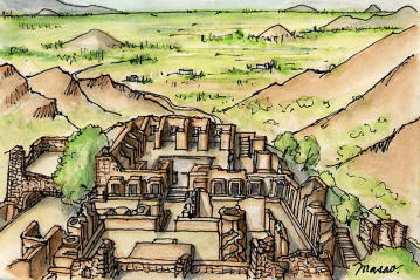
Takht means “throne” and bahi, “water” or “spring” in Persian/Urdu. The monastic complex was called Takht-i-Bahi because it was built atop a hill and also adjacent to a stream. Located 80 kilometers from Peshawar and 16 kilometers northwest of the city of Mardan, Takht-I-Bahi was unearthed in early 20th century and in 1980 it was included in the UNESCO World Heritage list as the largest Buddhist remains in Gandhara, along with the Sahr-i-Bahlol urban remains that date back to the same period, located about a kilometer south.
I have been there in 2003 and it is surprisingly well maintained and thankfully safe despite what the Taliban did across the border. Researchers believe that the monastery of Takht-i-Bahi was first mentioned by General Court, the French officer of Maharaja Ranjit Singh in 1836 and it is the most impressive and complete Buddhist monastery in Pakistan. Takht-i-Bahi consists of numerous chapels and stupas sticking to the high, rocky spurs. Just for reader’s information, a stupa is a Buddhist mound like structure and usually has a square base, a hemispherical dome, a conical spire, a crescent moon and a circular disc. Stupas were erected over the remains of Buddha, his disciples and other saints. They also hold objects traditionally associated with Buddha.
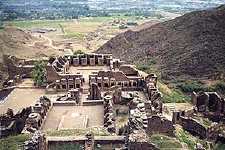
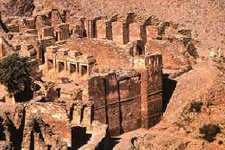
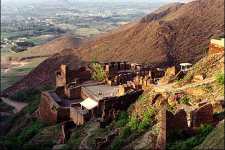
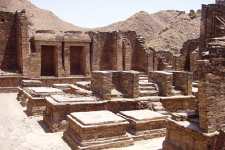
The complex of Takht-i-Bhai is impressively situated on a rocky spur (hill) some 300-500 feet above the Peshawar plain. From the top of the hill behind monastery, one can look down across the plains as far as Peshawar on one side and up to the Malakand Pass and the hills of Swat on the other and towards north is the Hindu Kush. This site has produced fragmentary sculptures in stone and stucco (a material made of an aggregate, a binder, and water which is applied wet, and hardens when it dries) that indicate the highly developed sculptural sense of their creators.
But the most remarkable feature is the design and arrangement of the range of small shrines, which surrounds the main stupa-court. The main stupa court at Takht-i-Bhai contained subsidiary stupas but was lined on three sides with larger and smaller image chapels with significant parts of their superstructure still intact. Much of the friezes and statuary was removed between 1907 and 1913, some of which can be seen on site and in museums in Pakistan.
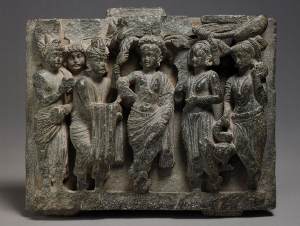 The Vinaya text (a word in PÄÂ?li as well as in Sanskrit, with literal meaning ‘humility’) which is the textual framework for the Buddhist monastic community, or sangha, throws light on the architecture of the monastery. The village is built on the ruins of the ancient town, the foundation walls of which are still in a tolerably good formation. As a proof, that it was in the past occupied by the Buddhists and Hindu races, coins of those periods are still found at the site, the monks constructed it for their convenience. Spring water was supplied to them on hilltops; living quarters for ventilators for light and alcoves for oil lamps were made in the walls. From the description of Song Yun, a Chinese pilgrim, it appears that it was on one of the four great cities lying along the important commercial route to India. It was a well-fortified town with four gates outside the northern one, on the mound known as Chajaka Dehri which was a magnificent temple containing beautiful stone images covered in gold leaves. Not far from the rocky defile of Khaperdra did Ashoka build the eastern gate of the town outside of which existed a stupa and a sangharama.
The Vinaya text (a word in PÄÂ?li as well as in Sanskrit, with literal meaning ‘humility’) which is the textual framework for the Buddhist monastic community, or sangha, throws light on the architecture of the monastery. The village is built on the ruins of the ancient town, the foundation walls of which are still in a tolerably good formation. As a proof, that it was in the past occupied by the Buddhists and Hindu races, coins of those periods are still found at the site, the monks constructed it for their convenience. Spring water was supplied to them on hilltops; living quarters for ventilators for light and alcoves for oil lamps were made in the walls. From the description of Song Yun, a Chinese pilgrim, it appears that it was on one of the four great cities lying along the important commercial route to India. It was a well-fortified town with four gates outside the northern one, on the mound known as Chajaka Dehri which was a magnificent temple containing beautiful stone images covered in gold leaves. Not far from the rocky defile of Khaperdra did Ashoka build the eastern gate of the town outside of which existed a stupa and a sangharama.
The group of buildings unearthed after archeological excavations at Takht-i-Bahi may include; the court of many Stupas, the monastery, the main stupa, the assembly hall, the low-level chambers, the courtyard, the court of three stupas, the wall of colossi and the secular building. In 1871, Sergeant Wilcher found innumerable sculptures at Takht-i-Bahi. Some depicted stories from the life of Buddha, while others more devotional in nature included the Buddha and Bodhisattava.
The Court of Stupas is surrounded on three sides by open alcoves or chapels. The excavators were of the view that originally they contained single plaster statues of Buddha either sitting or standing, dedicated in memory of holy men or donated by rich pilgrims. The monastery on the north was probably a double storied structure consisting of an open court, ringed with cells, kitchens and a refectory. Walking further, you will come across the monastery court which was a residential area and as such a small number of sculptures were recovered. However, a beautiful emaciated Siddhartha in three parts was discovered. Likewise the other courts with Buddha’s images in stucco are equally interesting and they were used either for meditation, meetings or storage.
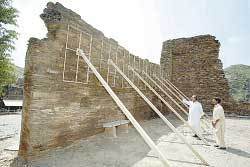 Regarding the current condition of this majestic site, although it is in good shape today, archeologists are warning that the site is in danger of collapse if an earthquake hits the region. The structure has been damaged by the quarrying operations, blasting activities and shock waves in the 90’s. Some walls at the ruins have been affected by rainwater, which began accumulating after passages in the ruins were paved as part of a maintenance project. The provincial archeology department has only five engineers to look after 74 ruins in the province, which is not enough to keep them all in proper repair. Although the Government of Pakistan has taken a number of steps to protect the ruins (including buying the quarrying company in 2002 to stop blasting and shock waves nearby) but much more needs to be done otherwise we will only find Takht-I-Bahi in history and archeology books.
Regarding the current condition of this majestic site, although it is in good shape today, archeologists are warning that the site is in danger of collapse if an earthquake hits the region. The structure has been damaged by the quarrying operations, blasting activities and shock waves in the 90’s. Some walls at the ruins have been affected by rainwater, which began accumulating after passages in the ruins were paved as part of a maintenance project. The provincial archeology department has only five engineers to look after 74 ruins in the province, which is not enough to keep them all in proper repair. Although the Government of Pakistan has taken a number of steps to protect the ruins (including buying the quarrying company in 2002 to stop blasting and shock waves nearby) but much more needs to be done otherwise we will only find Takht-I-Bahi in history and archeology books.
Sources: Checkout this wonderful Heritage Tour link (you need to have QuickTime installed) that gives a 360-degree view of the Buddhist monastery. Google Earth also presents an interesting view of this truly majestic site. More information available here, here and here.



















































The villages of Lund Khwar, Sher Garh Charsadda Sehri-Bahlol Takkar and Mazdoor Abad is another historical place in the vicinity of Takht-Bhai. Takkar is a historical village. The legend Sardar Ali Takkar belongs to this village, he is a well renowned singer of pashtu language. Takhtbai contains the remains of Buddha which has not been properly preserved.Alot of visitors national and international comes to this heritage site to see it.By developing such places more pakistan will take their advantage in terms of profit and tourism.
TakhtBhai is located near Peshawar and Mardan city. The monastic complex was called Takht-i-Bahi because it was built atop a hill and also adjacent to a stream. TakhtBhai is the most fertile Tehsil in the Mardan Division. This is old historical Buddha Place and it needs to preserve for the coming generations. In Pakistan research needed for such type of heritage sites which brings a lot of money and visitors to Pakistan. There are many crops grown in the Takht Bhai Tehsil, some of which are tobacco, wheat and sugar cane. Asia’s first sugar mill was built here by the British Government near the Buddhist monastery.
TakhtBhai are the village near Peshawar. It is famous due to the old historical heritage exits here. The site of that heritage contains old heritage items like old tools, utensils, stuppas and Buddhas.This site needs attention to preserve further it from more damage. This is also good site to visit because of its good location including river, mountains and its good weather. Pakistani government gives focus to it and also this site is now under the supervision on Ministry of culture Islamabad. I been there more times its really a good experience to visit to know about old people living standards. How they passed their time. A lot of local people get employment from this site and it brings good money and revenue to local people. Due to its importance this Historical Place is also listed in UN world Heritage.
Takht-I-Bahi is an impressive Buddhist Monastery in Pakistan. It is important to preserve it properly and also needs local people attention as well.it is registered under UN list and it needs to develop a Management plan to manage these places properly. It helps college students worldwide by providing the most extensive, lowest-priced service for Cultural Heritage research papers and thesis writing.i know TakhtBhai very well because I got married with a girl from this place. It is a wonderful place and whenever I visit takhtbhai I often see this old historical site of Buddhas because its near to us.
TakhtBhai is a small village type place near Peshawar .i saw this place and I was much insipired by the old people living style and standards. The site is a great source of information on Buddhism and the way of life people here used to follow. The village is built on the ruins of the ancient town, the foundation walls of which are still in a tolerably good formation. The monks constructed it for their convenience. Spring water was supplied to them on hill tops; living quarters for ventilators for light and alcoves for oil lamps were made in the walls. From the description of Song Yun, a Chinese pilgrim, it appears that it was on one of the four great cities lying along the important commercial route to India. Takht Bhai is well connected by road with the rest of the country.it will be a graet place for visitors and tourist type people.If it preserved properly and government pay good attention I think its a great asset for pakistan.